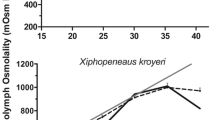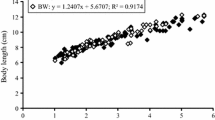Abstract
Specimens of Chlamys opercularis, Modiolus modiolus, Mytilus edulis, Crassostrea gigas, Scrobicularia plana and Mya arenaria were exposed to both gradual (sinusoidal) and abrupt (square-wave) salinity fluctuations and measurements made of osmotic, Na+, Mg2+ and Ca2+ concentrations in the hemolymph and where applicable in the mantle fluid. In both sinusoidal and square-wave regimes fluctuating between 100 and 50% seawater (100%=ca. 32‰ S), the hemolymph Na+, Mg2+, Ca2+ and osmotic concentrations followed the concentrations of the external medium in Chlamys opercularis. The hemolymph and mantle fluid osmotic Na+, Mg2+ and Ca2+ concentrations of Modiolus modiolus, Mytilus edulis, Crassostrea gigas and S. plana followed those of the external medium as long as the molluscs' shell valves remained open. There were no changes in the ionic or osmotic concentrations of the hemolymph or mantle fluid of any of these species during periods of shell-valve closure. The hemolymph osmotic, Na+ and Mg2+ concentrations of wedged-open Modiolus modiolus, Mytilus edulis, C. gigas and S. plana followed those of the external medium. Hemolymph Ca2+ concentrations showed a damped response in C. gigas and Mytilus edulis. The hemolymph osmotic, Na+, Ca2+ and Mg2+ concentrations of Mya arenaria fluctuated in a similar manner to the external medium, but were damped. Wedged-open Mytilus edulis exposed to fluctuating salinity and supplied with a constant supply of 10 mM Ca2+ showed greater changes in hemolymph ionic and osmotic concentrations than M. edulis exposed to the same salinity fluctuation without a constant Ca2+ supply. Chlamys opercularis and Modiolus modiolus survived in a 50% seawater minimum sinusoidal salinity fluctuation for 10 days; wedged-open M. modiolus survived only 3 days. Burrowing had no effect on the osmotic, Na+, Mg2+ or Ca2+ concentrations of the hemolymph of Mya arenaria or S. plana exposed to fluctuating salinities. All of the species studied were shown to be osmoconformers.
Similar content being viewed by others
Literature Cited
Anderson, J.D. and C.L. Prosser: Osmoregulating capacity in populations occurring in different salinities. Biol. Bull. mar. biol. Lab., Woods Hole 105, p. 369 (1953)
Basindale, R.: A comparison of the varying salinity conditions of the Tees and Severn estuaries. J. Anim. Ecol. 12, 1–10 (1943)
Bedford, W.B. and J.W. Anderson: The physiological response of the estuarine clam, Rangia cuneata (Gray) to salinity. I Osmoregulation. Physiol. Zoöl. 45, 255–260 (1972)
Brand, A.R. and D. Roberts: The cardiac responses of the scallop Pecten maximus to respiratory stress. J. exp. mar. Biol. Ecol. 13, 29–43 (1973)
Chapman, G. and G.E. Newell: The role of the body fluid in the movement of soft-bodied invertebrates. II. The extension of the siphons of Mya arenaria and Scrobicularia plana. Proc. R. Soc. (Ser. B) 145, 564–580 (1956)
Coleman, N. and E.R. Trueman: The effect of aerial exposure on the activity of the mussels Mytilus edulis and Modiolus modiolus. J. exp. mar. Biol. Ecol. 7, 295–304 (1971)
Conway, E.J.: Fundamental problems in hormonal control of water and salt electrolyte metabolism. In: The hormonal control of water and salt-electrolyte metabolism in vertebrates, Vol. 5. Pt. II. pp 3–22. Ed. by I.C. Jones and P. Eckstein. London: Cambridge University Press 1956 (Mem. Soc. exp. Endocr.)
—: Principles underlying the exchange of sodium and potassium ions across cell membranes. J. gen. Physiol. 43, (Suppl. 1), 17–41 (1960)
Davenport, J., Ll.D. Gruffydd and A.R. Beaumont: An apparatus to supply water of fluctuating salinity and its use in a study of the salinity tolerance of larvae of the scallop Pecten maximus L. J. mar. biol. Ass. U.K. 55, 391–409 (1975)
Fingerman, M. and L.D. Fairbanks: Osmotic behaviour and bleeding of the oyster, Crassostrea virginica. Tulane Stud. Zool. 3, 151–168 (1956)
Freeman, R.F.H. and F.H. Rigler: The responses of Scrobicularia plana (da Costa) to osmotic pressure changes. J. mar. biol. Ass. U.K. 36, 553–567 (1957)
Galstoff, P.S.: The American oyster. Fishery Bull. Fish Wildl. Serv. U.S. 64, 1–480 (1964)
Ghiretti, F.: Respiration. In: Physiology of Mollusca, pp 175–208. Ed. by K.M. Wilbur and C.M. Yonge, New York: Academic Press 1966
Gilles, R.: Osmoregulation in three molluscs: Acanthochitona discrepans (Brown), Glycymeris glycymeris and Mytilus edulis. Biol. Bull. mar. biol. Lab., Woods Hole 142, 25–35 (1972)
Gray, J.: The mechanisms of ciliary movement. IV. The relation of ciliary activity to oxygen consumption. Proc. R. Soc. (Ser. B) 96, 95–114 (1924)
Green, J.: The biology of estuarine animals, 401 pp. London: University of Washington 1968
Hayes, F.R. and D. Pelluet: The inorganic constitution of molluscan blood and muscle. J. mar. biol. Ass. U.K. 26, 580–589 (1947)
Hopkins, A.E.: Adaptation of the feeding mechanism of the oyster (Ostrea gigas) to changes in salinity. Bull. Bur. Fish., Wash. 48, 345–363 (1936)
Hoyeaux, J., R. Gilles and C. Jeuniaux: Osmoregulation in molluscs of the intertidal zone. Comp. Biochem. Physiol. 53A, 361–365 (1976)
Kinne, O.: Salinity: animals — invertebrates. In: Marine ecology. Vol. I. Environmental factors, Part 2. pp 821–995. Ed. by O. Kinne. London: Wiley Interscience 1971
Loosanoff, V.L.: Behavior of oysters in water of low salinities. Conv. Addr. natn. Shellfish. Ass. 1, 135–151 (1952)
— and P.B. Smith: Some aspects of behavior of oysters accustomed to different salinities. Anat. Rec. 105, p. 627 (1949)
Matthiessen, G.C.: Observations on the ecology of the soft clam Mya arenaria in a salt pond. Limnol. Oceanogr. 5, 291–300 (1960)
Milne, A.: The ecology of the Tamar estuary III. Salinity and temperature conditions in the lower estuary. J. mar. biol. Ass. U.K. 22, 529–542 (1938)
Pantin, C.F.A.: On the physiology of amoeboid movement. III. The action of calcium. Br. J. exp. Biol. 3, 275–295 (1926)
Papero, A. and J.A. Murphy: The effect of calcium on the rate of beating of lateral cilia in Mytilus edulis. I. A response to perfusion with 5-HT, DA, BOL and PBZ. Comp. Biochem. Physiol. 50C, 15–20 (1975)
Perkin-Elmer: Analytical methods for atomic adsorption spectrophotometry, p. EN-1. Norwich, Connecticut: Perkin Elmer 1973
Pierce, S.K.: The water balance of Modiolus (Mollusca: Bivalvia: Mytilidae): osmotic concentrations in changing salinities. Comp. Biochem. Physiol. 36, 521–533 (1970)
Potts, W.T.W. and G. Parry: Osmotic and ionic regulations in animals, 433 pp. London: Pergamon Press 1964
Prosser, C.L.: Comparative animal physiology, 456 pp. Philadelphia: W.B. Saunder's Co. 1973
Ricci, E.: L'adaptation de la moule commune. Mytilus galloprovincialis aux changements de salinité. Annls Fac. Sci. Marseille 12, 47–91 (1939)
Robertson, J.D.: The function and metabolism of calcium in the Invertebrata. Biol. Rev. 16, 106–133 (1941)
—: Ionic regulation in some marine invertebrates. J. exp. Biol. 26, 182–200 (1949)
—: Osmotic and ionic regulation. In: Physiology of the Mollusca, Vol. I. pp 283–311. Ed. by K.M. Wilbur and C.M. Yonge. New York: Academic Press 1964
Schlieper, C.: Osmotic resistance of gills of Mytilus. Helgoländer wiss. Meeresunters. 14, 482–502 (1966)
Schoffeniels, E. and R. Gilles: Ionoregulation and osmoregulation in mollusks. In: Chemical zoology, Vol. 7. pp 393–420. Ed. by M. Florkiss and B. Scheer. New York: Academic Press 1970
Stickle, W.B. and R. Ahokas: The effects of tidal fluctuation of salinity on the perivisceral fluid composition of several echinoderms. Comp. Biochem. Physiol. 47A, 469–476 (1973)
——: The effects of salinity on the hemolymph composition of several molluscs. Comp. Biochem. Physiol. 50A, 291–296 (1975)
Stickney, R.R.: Determination of sodium, calcium, magnesium and potassium in channel catfish blood plasma. Bull. Ga Acad. Sci. 29, 163–168 (1971)
Topping, F.L. and J.L. Fuller: The accommodation of some marine invertebrates to reduced osmotic pressure. Biol. Bull. mar. biol. Lab., Woods Hole 82, 372–384 (1942)
Tucker, L.E.: Effects of external salinity on Scutus breviculus (Gastropoda, Prosobranchia) — I. Body weight and blood composition. Comp. Biochem. Physiol. 36, 301–319 (1970)
Van Dam, L.: On the utilization of oxygen by Mya arenaria. J. exp. Biol. 12, 86–97 (1935)
Webb, D.A.: Ionic regulation in Carcinus maenas. Proc. R. Soc. (Ser. B) 129, 107–136 (1940)
Webb, J.L.: The ecology of Lagos lagoon, III. The life history of Branchiostoma nigeriense Webb. Phil. Trans. R. Soc. (Ser. B) 241, 335–353 (1958)
Yazaki, M.: On the osmoregulation of the blood of several marine and fresh water molluscs. I. The Japanese oyster, Ostrea circumpicta. Sci. Rep. Tôhoku Univ. (Ser. 4) 7, 229–238 (1932)
Zachary, A. and D.S. Haven: Survival and activity of the oyster drill Urosalpinx cinerea under conditions of fluctuating salinity. Mar. Biol. 22, 45–52 (1973)
Author information
Authors and Affiliations
Additional information
Communicated by J.H.S. Blaxter, Oban
Rights and permissions
About this article
Cite this article
Shumway, S.E. Effect of salinity fluctuation on the osmotic pressure and Na+, Ca2+ and Mg2+ ion concentrations in the hemolymph of bivalve molluscs. Mar. Biol. 41, 153–177 (1977). https://doi.org/10.1007/BF00394023
Accepted:
Issue Date:
DOI: https://doi.org/10.1007/BF00394023




